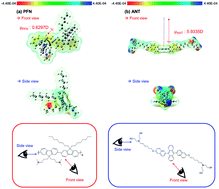Excellent carrier transport materials produced by controlled molecular stacking and their application in flexible organic electronic devices†
Abstract
Research studies based on flexible organic electronic devices regarding the relationship between carrier transport and molecular stacking are actively reported. For enhancing carrier transport and mechanical strength, new types of anthracene derivatives (ANT), exhibiting parallel dominant molecular stacking characteristics, are designed and synthesized. They show parallel dominant molecular stacking properties inducing excellent carrier transport through hybridization with perpendicular materials. They are introduced as electron transport layers (ETLs) for organic solar cells (OSCs), organic light emitting diodes (OLEDs), and organic nano-generators (ONGs). Hybrid ETLs show excellent carrier transport characteristics, exhibiting minimized energy loss and suppressed carrier recombination resulting from relative resonance through partial polarization of ANT. Consequently, the power conversion efficiency (PCE) of the fabricated OSCs based on fullerene and non-fullerene systems reaches 9.6% and 11.4%, and the luminescence of OLEDs reaches up to 17 057 cd m−2. In addition, flexible OSCs, OLEDs, and ONGs show improved output performance and mechanical strength due to excellent carrier transport. Especially, in flexible ONGs, high carrier transport can be helpful for enhancing output voltage by energy level shifting.



 Please wait while we load your content...
Please wait while we load your content...